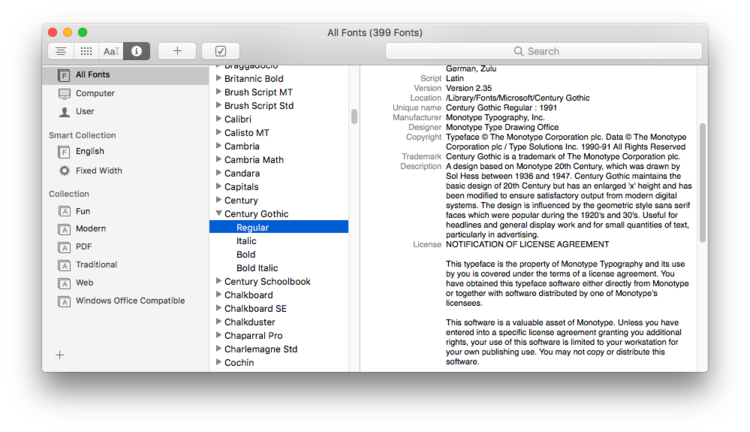Preface: Since there’s so much seemingly conflicting information out there, I’ve quite possibly gotten it wrong. If so, please let me know so I can correct this!
End Use License Agreements are confusing. Most people don’t read them, even when they occasionally embed easter eggs, (according to this site, most designers don’t regularly read them when it comes to the typefaces they use), and when they do probably don’t understand them (or else why would sites like ToS;DR exist?).
Since part of my job is to teach kids about not just applications of technology but also the legalities and ethics of doing so, obviously I need to (try to) understand this stuff myself. We look at the different topics like copyright, alternative licenses such as Creative Commons and releasing content into the public domain, and dip into the murkiness of Fair Use/Fair Dealing. When it comes to the use of images, sound etc although it often isn’t easy to understand, there has been enough focus on it that good resources exist and students can usually wrap their heads around it (I once subjected my students to A Fair(y) Use Tale, but won’t try that twice - nice in theory, more difficult to follow).
Software licensing is generally pretty clear-cut and easy for students to understand (although I think the rise of the freemium model is actually making it much harder to grasp, considering the distinction between licensing and owning), but something that I’ve never really dived into is the use of typefaces. Recently (as in, this year) I’ve been thinking about this more, prompted by an episode of Jeff Veen’s Presentable podcast. It finally hit the front of my playlist around the time that my wife was starting up her own business and we were thinking about logo design, and I was hit with the realisation that I didn’t actually understand that much about typefaces and their licensing.
A few different situations exist in the use of a typeface (probably more than is in this list):
- I want to use a typeface as part of a design for publication (as part of an image, in a PDF/ePub for printing etc). At some point it will be rasterised/converted to a path for either display on screen or printing.
- For use in a web site so that visitors do not need to have it installed on their computer and can see your design (hosted on your server or linked from a collection such as Google Fonts or TypeKit.
- Installed as part of an application.
- For future use in design material.
- Modification of the typeface for a derived design.
When reading up on this, there seems to be a lot of confusion in what uses fit into the different categories, particularly the first and fourth. This isn’t helped by the third category, and how typefaces are installed onto computers (i.e. into a central repository).
First of all, fonts are software, and as such are licensed, not purchased. This includes all the per-computer licensing woes that plague much of the software world, you don’t buy a license for yourself, you buy a license for it to be installed on n computers at once. So what about all those fonts already installed on your computer? Those are part of a bundle (see #3 in the list above) such as the operating system or another piece of software like a word processor or design tool.
As part of this ordeal, I discovered (through Keystone Law’s article on font use) that Mac OS’s Font Book has licensing information included, as well as information on the storage location and origin of fonts installed. It distinguishes between fonts you have installed manually, and those which have been installed system-wide (such as through MS Office).

Mac OS Font Book
One of the things which I found confusing trawling questions on StackExchange is who needs to own the license for use of a font in some sort of visual design. My understanding of it is that, unless specified in the EULA, a desktop license is sufficient for this (the difficulty is that some EULAs require a different license for commercial use). That is, I either use a font installed on my computer, or purchase a font for this use. If I then use this font as part of a design that will be printed or otherwise digitally published (in a form that doesn’t require the font to be installed) then that’s sufficient. Where it gets more complicated is if the client wants to use that font themselves to produce other material, in which case they need a license themselves for however many computers it will be installed on (or I could purchase a license on their behalf during design and then remove the font from any computers I used at the end of the job).
There seems to be a bit of confusion about the need for extra licenses when sending off work to be published, but the consensus appears to be that this is allowed (print shops that I’ve dealt with ask that type be converted to curves before being sent - this is the case outlined by this MyFonts article, although this doesn’t seem very practical when dealing with larger works like books and other larger print documents).
Here’s a list of articles which I fount useful reading up on this topic.
- DesignShack - What is a font license? (And do I need one?)
- Typography.com - Introduction to Licensing & Usage
- Keystone Law - A simple introduction to Font Licensing
- The Logo Smith - A brief summary on font licensing: Some do’s and dont’s
- MyFonts - Usage in a logo
- HOW Design - Top 5 ways designers get themselves in trouble with fonts